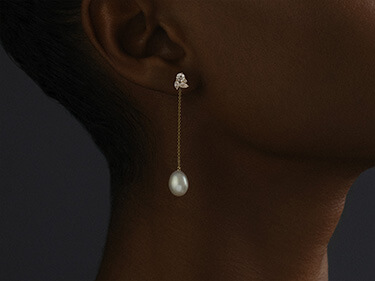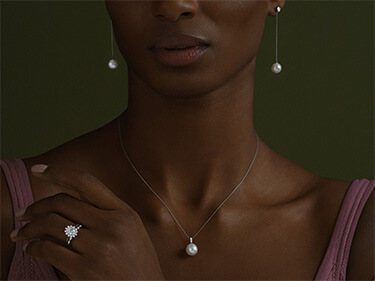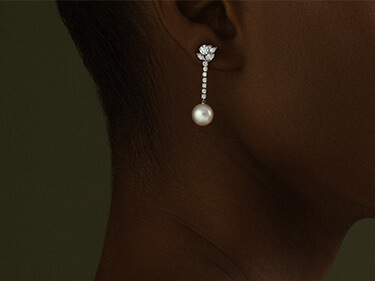Guide to Pearls
With their soft sheen and delicate finish, pearls are truly something to behold. But what makes a pearl? How do you choose the ideal gem? Today, 77 Diamonds unveils for you the precious world of this precious gem.
Jump to:
- A Bright History
- How are Pearls Formed?
- Pearl Types at 77
- Choosing Your Pearl Jewellery
- Ideal for Gifting
- How to Care for Pearls
A Bright History
A long held tradition, our fascination for pearls dates back millennia. Upon landing in what was then the ‘New World’ in 1492, Christopher Columbus recorded native tribes wearing pearls as ornamental jewellery. Historians have also found some pearl jewels dating back 2206 BC in China.
Due to the sheer scarcity of natural pearls, and to accommodate the rise in demand for pearl jewellery, a Japanese entrepreneur named Kokichi Mikimoto was the first to successfully culture pearls in 1893. Since then, pearl farms have become the main source of the world’s pearl production, with many varieties and colours appearing on the market.
How are Pearls Formed?
Unlike mineral gems, such as diamonds or sapphires, pearls are the only gems created by a living creature. Many types of molluscs create pearls, however, pearls worn in jewellery are mostly cultured in oysters or freshwater mussels.
To create a pearl, a small irritant is introduced into the oyster or mussel. The natural response for the animal is to create protective layers around the irritant, called ‘nacre’. Usually, the irritant is tissue from another mollusc attached to a small bead. The tissue promotes the secretion of nacre, which in turn envelops the bead. Nacre is made of a carbon-based mineral called Aragonite and an organic secretion called Conchiolin that binds the mineral together.
Over the course of a few months or several years, depending on the type of molluscs, a delicate sphere forms inside the animal. Due to the layers of nacre deposited, a pearl’s surface reflects light in such a way to create incredible iridescence and lustre.
Once a pearl is harvested, the oyster or mussel can either be re-sealed with another bead, or eaten and recycled for its shell. It is thought that the procedure doesn’t hurt the animal, as oysters and mussels do not have a nervous system.
Pearl Types at 77
Freshwater
Freshwater pearls have a warm glow, and can usually be found in a range of shapes and sizes. The freshwater pearls featured in the Pearl Collection present a slight oval or teardrop shape, known as ‘baroque’.
One single freshwater mussel can create multiple pearls over a time-span of 6 months to several years, depending on the mussel. Because of this, freshwater pearls are more readily available, and therefore come at a more affordable price. Freshwater pearls are the ideal choice for those looking to purchase a first-time pearl piece, or June birthstone jewellery.

Akoya
Akoya pearls originated in Japan, and were the first type of cultured pearls to exist. These pearls come from a long tradition of pearl farming, and hold an eye-catching lustre and sheen. Premium Akoyas can command high prices, as they take around 10 to 18 months to form, with only one pearl per oyster. In the 77 Pearl Collection, we provide perfectly spherical Akoya pearls.

South Sea
South Sea pearls are by far the rarest and most prestigious type of pearl in the 77 selection. These pearls can sometimes be larger than freshwater or Akoya pearls, and come in a variety of colours, whether gold, champagne, or white.
Their intense lustre and shine makes for truly mesmerising jewellery pieces, and the rarest South Sea pearls command very high prices. Their scarcity is due to their only being cultured in certain areas of the world, mainly Australia and the Philippines, and taking 2 to 3 years to form in the oyster.

Choosing Your Pearl Jewellery
Like any gem, pearls vary in shape and colour. At 77 Diamonds, we offer a selection of bright white pearls in round and teardrop shapes. Each gem is meticulously checked to reflect superior quality based on a combination of factors.
Size
A pearl’s size, measured in millimetres, may affect its overall price. Usually, the larger the pearl, the rarer and more costly it is. However, certain small pearls may be more expensive depending on other quality factors.
Shape
Pearls are organically created and can therefore vary in shape. Certain designers do prefer irregular shapes for a more contemporary take on pearl jewellery, however, it is widely accepted that pearls should be perfectly symmetrical.
Lustre
Lustre is probably the most crucial factor affecting a pearl’s quality, as it measures overall visual appearance. Lustre indicates how well a pearl’s surface reflects light, the sharpness of its reflections, as well as its capacity to radiate an inner glow. Superior pearls display a mesmerising lustre that catches the eye, while inferior pearls present a somewhat dull and blurred appearance.
Colour
This factor relates to a pearl’s dominant colour, subtle overtones, as well as any intricate hues displayed on its surface. These combined qualities create a hypnotic play of colour that glides gracefully over a pearl, bringing depth and a distinct glow to your jewellery.
Surface
When a pearl forms inside an oyster or mussel, it can sometimes be damaged by several factors and affect its surface quality. The most sought-after pearls have little to no surface blemishes, making them extremely rare and expensive.
Depending on their grading quality, certain pearls may hold very slight abrasions or blemishes that are difficult to see. At 77 Diamonds, we only provide pearls that present very few blemishes, practically invisible to the untrained eye.
Nacre
Nacre is the substance formed by an oyster or mussel to create a pearl. As nacre progressively deposits itself in layers around the seed irritant, it forms a distinct glow. Nacre and lustre generally go hand in hand –- a thick nacre usually indicates superior lustre and finish.
Matching
Pearl jewellery often features multiple pearl pieces either placed in a gradient, or similar in size. A jewel’s quality is determined by how well the pearls resemble each other, especially in earrings or necklaces. At 77 Diamonds, we individually select each pearl to achieve a near perfect matching quality.
Ideal for Gifting
Pearls make for meaningful gifts, especially when chosen to celebrate a special event or a lifelong achievement. Symbolising purity and innocence, pearls were traditionally given to a bride on her wedding day, however, their meaning can be attached to so much more.
As June’s birthstone, pearls are ideal birthstone jewellery gifts, especially for those looking to wear finely-crafted jewellery for the first time.
Through the pearl collection, our designers look to harness the beauty of pearls in a more contemporary fashion, forming delicate pieces ideal for gifting.
How to Care for Pearls
Pearls are meant to last a lifetime, and when properly taken care of — they will. To preserve your pearl’s iconic glow, it’s important to remember some simple Pearl Golden Rules, courtesy of 77.
Rule 1. Last on, first off.
Pearls are organically created, so they can be quite delicate. Please avoid any harsh product coming into contact with your jewellery. Cosmetics, moisturisers and perfume may damage the pearl and its jewellery setting. It’s always best to wear your pearls last when getting ready, and take them off first.
Rule 2. Keep me safe.
The outer surface of a pearl can be prone to scratches and blemishes. After years, excessive damage may affect your pearl’s sheen. To prevent this, always keep them separate from your other jewellery, preferably in a satin pouch and on a flat surface.
Rule 3. Love me. Wear me.
To look their best, pearls need a little moisture. If direct sunlight or heat is applied too often, or if you keep your pearls hidden away for too long, they might dry out. The slight heat and moisture they receive when worn is ideal to maintain their appearance, so if you love them — wear them!
How to Clean your Pearls
After wearing your pearls, you can lightly clean them with a soft, non-abrasive cloth to remove any oil or impurities from the day. For a deeper clean, we recommend dabbing a soft cloth in warm soapy water and gently wiping your pearls. Please do not immerse your pearls in water, as this may damage the binding holding the pearls and jewellery together. Once cleaned, let your pearls air dry before storing.
